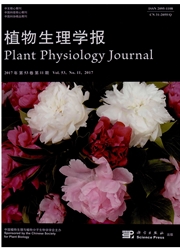

 中文摘要:
中文摘要:
植物对同种昆虫重复取食做出更有效的响应是植物适应自然界虫害周期性爆发的重要策略。为了研究蒙古沙冬青对其主要害虫灰斑古毒蛾幼虫重复取食响应的代谢基础,本实验采用基于核磁共振(NMR)的代谢组学技术,分析了遭受同一年不同代灰斑古毒蛾幼虫取食的蒙古沙冬青叶片和对照组幼苗叶片的代谢差异。结果表明,仅遭受第一代幼虫取食叶片在第二代幼虫期与对照之间代谢物存在较小差异,而仅遭受第二代幼虫取食叶片与遭受两代幼虫取食叶片代谢差异显著,仅遭受第一代与仅遭受第二代幼虫取食的植株相邻分枝叶片差异显著。另外,只有仅遭受第二代幼虫取食组幼苗表现出处理叶片与相邻分枝叶片的显著代谢差异,并且这种代谢差异为总体代谢的变化,而并未表现为特定代谢物含量变化。由此可见,蒙古沙冬青能在代谢水平以很小的代谢变化来保存昆虫取食信息,在遭受同种昆虫取食后,代谢差异被放大,而且这种信息保存在遭受取食叶片中表现更明显。
 英文摘要:
英文摘要:
More effective response to attack by subsequent conspecific herbivores in plants may be important strategies to adapt to periodic outbreaks of some insects, however, the mechanism for plants to respond to this kind of attack remains unclear. In order to investigate the metabolic basis of Ammopiptanthus mongolicus for periodic attack of Orgyia ericae, seedlings infested with different generations of O. ericae larvae that lived in early-season and later-season of a year were analyzed with nuclear magnetic resonance (NMR)-based metabolic technology. Results presented in this experiment indicated that leaves attacked by early-season herbivores showed a minor difference in metabolic profiling at the later season compared with control, whereas leaves attacked by later-season herbivores showed significant difference compared with leaves infested with both early-season and later-season herbivores. For leaves on sister branches, only leaves from seedlings infested with early-season and later-season herbivores showed significant difference. Additionally, significant difference between local and leaves on sister branches only existed in seedlings attacked by later-season herbivores. Therefore, A. mongolicus save the information of O. ericae larvae infestation with minor metabolic changes mainly in local leaves, which would be amplified when attacked by conspecifics.
 同期刊论文项目
同期刊论文项目
 同项目期刊论文
同项目期刊论文
 期刊信息
期刊信息
